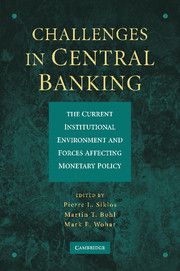 Challenges in Central Banking
Challenges in Central Banking Published online by Cambridge University Press: 06 December 2010
Abstract
Since the move toward more central bank transparency, a lot of research on its desirability from an economic viewpoint has been carried out. We provide an up-to-date overview of this transparency literature. First, we show how the theoretical literature has evolved by looking into branches inspired by Cukierman and Meltzer (1986) and by investigating several, more recent research strands (e.g., coordination and learning). Then, we review the empirical literature that has been growing recently. Last, we discuss whether the empirical research resolves all theoretical question marks, how the findings of the literature match the actual practice of central banks, and where there is scope for more research.
Introduction
Central banks used to be very secretive, but in the last two decades a lot of central banks have changed their regime into a more transparent one. As central banks became independent, transparency gained importance because it is a necessary prerequisite of accountability, for which the need increased. An additional reason why transparency came into prominence is its likely influence on the formation of expectations. With the increased importance of financial markets, managing inflation expectations has become key in monetary policymaking. It determines the success of the transmission of monetary policy. There are several benefits from successfully steering market expectations, like reduced uncertainty, improved planning of market participants, lower interest rate volatility, and more effective monetary policy (e.g., Issing 2005). It is, however, not obvious whether transparency actually improves the steering of market expectations.
To save this book to your Kindle, first ensure no-reply@cambridge.org is added to your Approved Personal Document E-mail List under your Personal Document Settings on the Manage Your Content and Devices page of your Amazon account. Then enter the ‘name’ part of your Kindle email address below. Find out more about saving to your Kindle.
Note you can select to save to either the @free.kindle.com or @kindle.com variations. ‘@free.kindle.com’ emails are free but can only be saved to your device when it is connected to wi-fi. ‘@kindle.com’ emails can be delivered even when you are not connected to wi-fi, but note that service fees apply.
Find out more about the Kindle Personal Document Service.
To save content items to your account, please confirm that you agree to abide by our usage policies. If this is the first time you use this feature, you will be asked to authorise Cambridge Core to connect with your account. Find out more about saving content to Dropbox.
To save content items to your account, please confirm that you agree to abide by our usage policies. If this is the first time you use this feature, you will be asked to authorise Cambridge Core to connect with your account. Find out more about saving content to Google Drive.